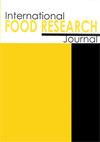Comparative study of physicochemical and functional properties of different buckwheat varieties and their milling fractions
IF 0.7
4区 农林科学
Q4 FOOD SCIENCE & TECHNOLOGY
引用次数: 0
Abstract
The present work evaluated the physicochemical and functional characteristics of different indigenous buckwheat varieties grown in Gilgit Baltistan, Pakistan, using grains and milled flour (fine flour, coarse flour, bran, and husk). Results showed that the thousand grain weight, length, width, thickness, arithmetic mean diameter, and geometric mean diameter were found to be highest in common buckwheat. In contrast, the highest mean values for sphericity were observed in Tartary buckwheat. The water absorption capacity, oil absorption capacity, swelling capacity, foaming, and foaming stability were high in common buckwheat as compared to Tartary buckwheat. Results regarding chemical properties revealed that common buckwheat contained higher quantity of protein (14.67%), fat (3.86%), fibre (1.38%), ash (2.24%), and total carbohydrate (65.8%); while Tartary buckwheat contained moisture (13.31%), protein (11.9%), fibre (1.38%), fat (3.57%), ash (2.69%), and total carbohydrate (68.8%). Furthermore, during the comparison of milling factions, it was found that buckwheat husk contained the highest quantity of copper (6.78 mg/100 g) and manganese (32.79 mg/100 g), while fine flour proved to be a rich source of magnesium. The present work identified variability among buckwheat varieties and milling fractions for physicochemical and nutritional traits that could be used to supplement various food products as functional ingredients.不同荞麦品种及其磨粒理化及功能特性的比较研究
本研究评估了在巴基斯坦吉尔吉特巴尔蒂斯坦种植的不同本土荞麦品种的物理化学和功能特性,使用谷物和碾磨面粉(细面粉、粗面粉、麸皮和麸皮)。结果表明,千粒重、长度、宽度、厚度、算术平均直径和几何平均直径均以普通荞麦最高。相比之下,在苦荞中观察到的球形度平均值最高。普通荞麦的吸水能力、吸油能力、溶胀能力、起泡能力和起泡稳定性都比苦荞高。化学性质分析结果表明,普通荞麦含有较高的蛋白质(14.67%)、脂肪(3.86%)、纤维(1.38%)、灰分(2.24%)和总碳水化合物(65.8%);苦荞含有水分(13.31%)、蛋白质(11.9%)、纤维(1.38%)、脂肪(3.57%)、灰分(2.69%)和总碳水化合物(68.8%)。此外,在碾磨派系的比较中,发现荞麦壳的铜含量最高(6.78 mg/100 g),锰含量最高(32.79 mg/100 g),而细面粉是镁的丰富来源。本工作确定了荞麦品种和碾磨组分之间的理化和营养性状的差异,可用于补充各种食品的功能成分。
本文章由计算机程序翻译,如有差异,请以英文原文为准。
求助全文
约1分钟内获得全文
求助全文
来源期刊

international food research journal
Agricultural and Biological Sciences-Food Science
CiteScore
1.40
自引率
0.00%
发文量
75
期刊介绍:
The International Food Research Journal (IFRJ) publishes papers in English, six (6) issues a year with the coverage of:
Food Science and Technology
Nutrition and Dietetics
Agriculture, multidisciplinary
Chemistry, multidisciplinary
The scope of the Journal includes:
Food Science, Food Technology and Food Biotechnology
Product Development and Sensory Evaluation
Food Habits, Nutrition, and Health
Food Safety and Quality
Food Chemistry, Food Microbiology, Food Analysis and Testing
Food Engineering
Food Packaging
Food Waste Management
Food Entrepreneur
Food Regulatory
Post-Harvest Food Management
Food Supply Chain Management
Halal Food and Management
 求助内容:
求助内容: 应助结果提醒方式:
应助结果提醒方式:


